Table of Contents
Society has given the idea of “intuition,” or simply knowing when something is correct or wrong, a great deal of respect, importance, and influence. In fact, according to some studies, more than half of Americans rely on their “gut” in order to decide what to believe, even when they are confronted with evidence that speaks to the contrary. While intuition may be useful in some circumstances, it would be foolish to ignore available quantitative tools when making important decisions.
What is Data-Driven Decision Making?
The practice of utilizing data to support decision making and confirm a course of action before committing to it is known as data-driven decision making (DDDM).[1] This process may take a variety of forms in business. For instance, an organization might:
- Gather survey responses to learn what features, products, and services their customers would like
- Carry out user testing to observe how customers are likely to use their products or services and to identify potential issues that should be resolved before a full release
- Launch a new product or service in a test market to gauge the market’s reaction
- Examine changes in demographics
Several variables, including a company’s objectives and the available types and quality of data, affect how precisely data may be incorporated into the decision-making process. Utilizing data to make choices is something that every contemporary company should emphasize and place at the core of their culture. DDDM provides multiple benefits,[2] including:
1. Ongoing expansion of the organization
- Consistency and ongoing development are fundamental aspects of data that influence decisions.
- Companies can focus on critical insights based on a variety of functions, operations, and departmental activities thanks to DDDM.
- Making consistent decisions and following through on them enables organizations to create attainable goals that lead to ongoing development and growth, which are essential components of long-term success in today’s competitive digital world.
2. Knowledge and innovation
- A piece in The Wall Street Journal[3] discussed a study conducted by professors Andrew McAfee and Erik Brynjolfsson of the MIT Sloan School of Management involving the MIT Center for Digital Business. In this study, the researchers found that the organizations examined achieved 4% greater productivity and 6% higher profits when they were predominantly data driven.
- Information is typically seen as a genuine asset more by businesses that use a collaborative approach to decision making than by businesses that take other, less clear-cut approaches. Additionally, organizations that see digital insights as a true asset promote a culture of data-driven education, creating a business environment where everyone uses information to their advantage to advance their knowledge and perform to the best of their ability.
3. New business opportunities
- Making decisions based on data results in the identification of fresh and intriguing business prospects. A company may get a comprehensive overview of its main operations by digging deeper into easily available visual information. This can help employees make a series of wise decisions that will advance company’s commercial development.
- Armed with deep-dive insights that improve their judgment, employees can also uncover opportunities to expand their growth, create new professional connections, and develop innovations that will give the organization an all-important edge over the competition.
4. Better communication
- Employees who work with a data-driven decision management attitude improve as leaders, which can spread throughout the whole business. Working with strong KPIs and visualizations enhances communication across the organization, whether in data-driven finance, a data-driven sales strategy, or any other type of insight-driven endeavor.
- When they operate as one unified data-driven entity, each of the organization’s departments can easily exchange insights and work together on crucial plans. The result is a more intelligent and successful company overall.
5. Unrivaled adaptability
- Last but not least, DDDM has the significant advantage of making organizations incredibly adaptive.
- The digital world is always evolving; to keep up, companies must use data to help make more educated and effective business decisions.
- Using data-driven decision-making tools enables personnel to identify and connect with new trends and patterns that affect both internal activities and the broader industry. The resulting judgments can help guarantee that the organization remains competitive, relevant, and lucrative.
Coatings Market Intelligence – A Case Study
Currently, coatings formulators and raw material producers may have an incomplete picture of industry dynamics. Data noise can be confusing and lead to conflicting perceptions of the market’s reality, and the formulator might not even have specific staff members responsible for performing market research.
Consider a vice president of global marketing for a multinational coatings formulator that produces coatings for the North American automotive OEM industry. Our VP is looking to gather the market data required to guide an effective expansion strategy, as the company is contemplating the possibility of entering the European market.
Using a tool that fuses cutting-edge research methodology with sector knowledge,* the VP can see that the Automotive OEM market in North America was 54 million gal valued at around $1.5 billion in 2022.
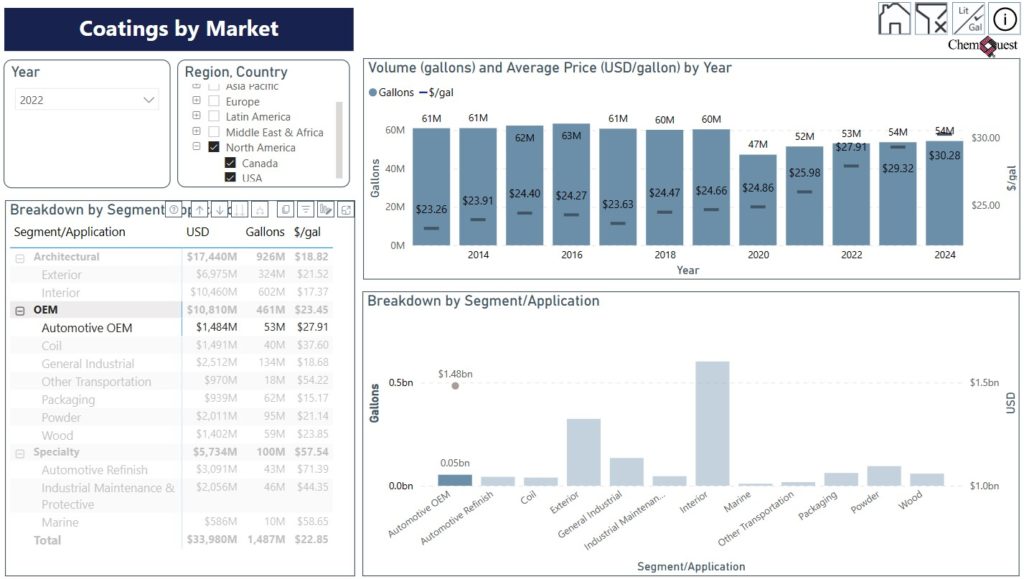
The VP can then examine the U.S. transportation industry to find the most recent trends affecting automotive OEM coatings before moving on to researching the European market.
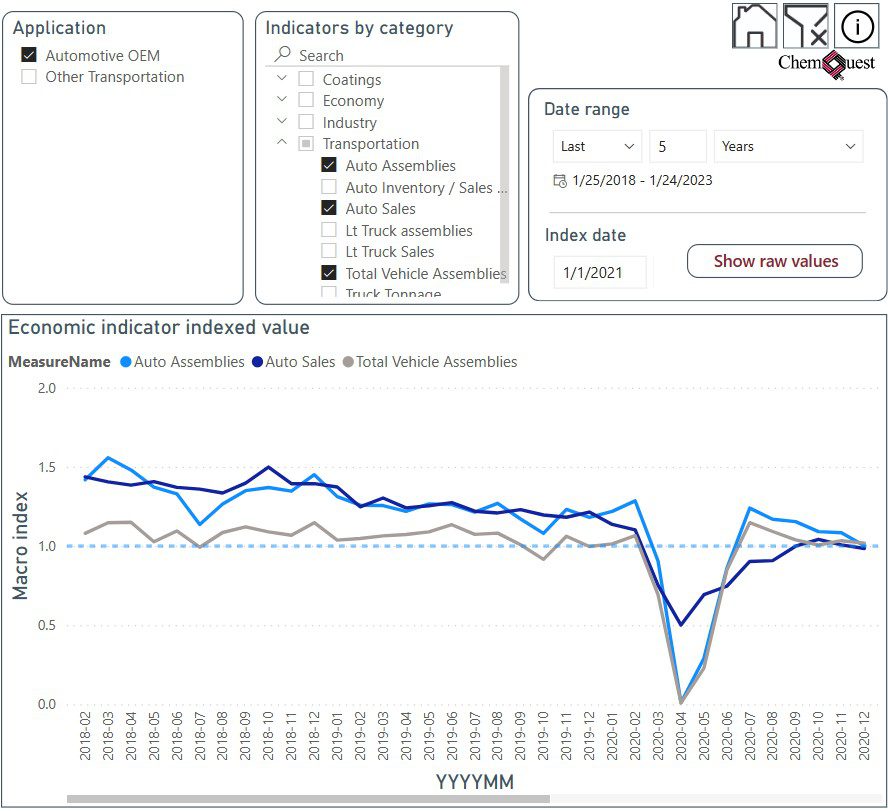
They notice that Auto Assemblies/Total Vehicle Assemblies took a dramatic dive during the pandemic, and Auto Sales followed suit. Recently, Vehicle Assemblies have recovered and stabilized, indicating that the end market has stabilized and may even be growing. However, the VP would need more evidence to support this claim.
When the VP then examines Vehicle Assemblies, they find that this end market indicator went to a Business Cycle “B” in September 2022 and has remained there ever since.
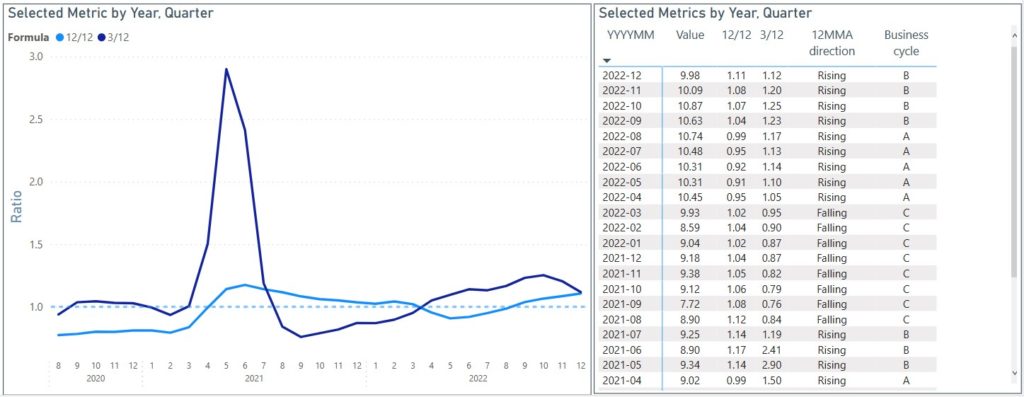
A Business Cycle “B” indicates that the rate of growth is increasing, and thus the prospect of vehicle assemblies increasing is likely. While this is promising for the Transportation end market, the VP observes that the 3/12 line (three-month moving average year over year) is teasing a crossover with the 12/12 line (12-month moving average year over year). This often denotes a shift in the business phase, whether good or bad.
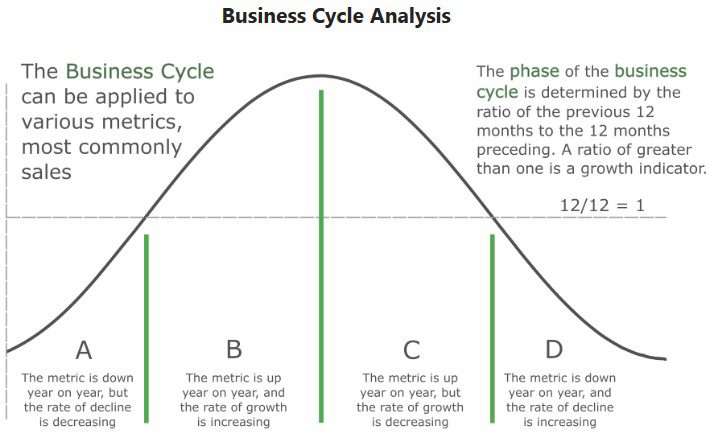
As the VP looks at the growth trajectory for Automotive OEM coatings over the same period, they confirm this trend. The VP can clearly see growth was stunted during 2020 when looking at the compound annual growth rate (CAGR) with respect to volume.
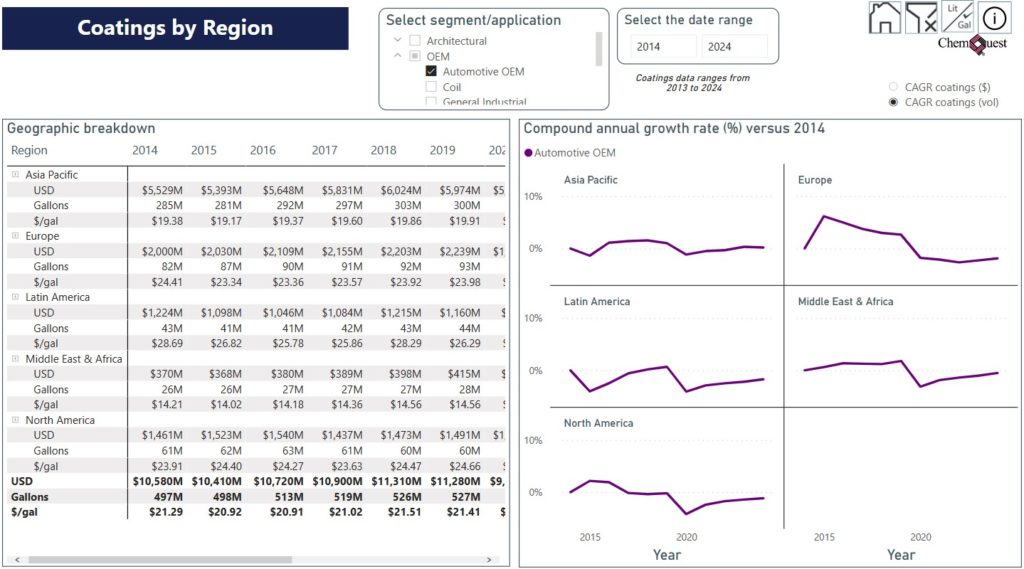
Additionally, the VP sees that Europe’s growth projection is not promising, which is something to take into account when thinking about targeting that region’s end market.
Using this data-driven information, the VP of global marketing should remain hopeful about growing the company’s market share in North America but may decide against pursuing the European market, given the region’s mediocre growth outlook.
Understanding Market Intelligence
Fundamentally, market intelligence enables businesses to capitalize on shifting dynamics while improving their understanding of consumers, rivals, and markets. Market intelligence makes it possible to identify unmet client needs and transform them into something useful. It helps companies learn about the actions or tactics they should take to increase their level of market competition. In addition, market intelligence is essential for emerging organizations’ marketing strategies, as it helps them add value for consumers and boost performance.
As the interaction between these factors becomes more complex, businesses are spending more in an effort to match the innovation process with market expectations. Businesses that use market intelligence data may speed up innovation, comprehend the market’s size and development potential, and pinpoint strategic intersections.
Chemical enterprises, in particular, must strive to keep up with market developments in order to combat disruptions and prepare for a drastically different tomorrow. Although growing urbanization has accelerated expansion in emerging economies, it is difficult for new businesses in the chemicals market to keep up with volatile market pressures. Organizations must develop new growth strategies to meet the rising demand and progress in the chemical industry:
- Greater comprehension of target markets – discover the whitespaces for innovation, decide how best to distinguish and position the company’s products and services, and comprehend the underlying reasons affecting business success
- Study market demands and difficulties – examine the demands of a target market and create plans to promote development and profitability with the aid of chemicals market intelligence products
- Recognize market dynamics – access market information and competitive insights to assess market dynamics
Manufacturing footprints are shifting throughout the chemicals sector, and new clients are appearing in a wide range of locales and markets. To attain a competitive edge, chemical businesses must concentrate on modifying and improving their business models, spotting prospective possibilities, and employing new technologies.
Utilizing dependable market information, in-house tools, and in-depth research enables organizations to spot emerging and long-term trends, anticipate pricing, evaluate rivals, and seek out business opportunities throughout the world’s chemical feedstock marketplaces and end-product sectors.
Beyond Intuition
Fundamentally, using data for decision making entails employing verified, studied information rather than intuition. Although the fictional VP discussed here provided just one short example, it is clear that market intelligence tools can optimize the DDDM process and ultimately help organizations make the business decisions they need to achieve their goals.
To learn more, contact the author at mrezai@chemquest.com.
*Coatings TraQr™, developed by and available from The ChemQuest Group, Inc.
References
1. Stobierski, Tim, “The Advantages of Data-Driven Decision-Making,” Harvard Business School Online Business Insights, August 26, 2019, https://online.hbs.edu/blog/post/data-driven-decision-making.
2. Calzon, Bernadita, “Why Data Driven Decision Making is Your Path to Business Success,” datapine, https://www.datapine.com/blog/data-driven-decision-making-in-businesses/.
3. R. Stross, “The Future on Fast Forward,” The Wall Street Journal, July 5, 2017, https://www.wsj.com/articles/the-futureon-fast-forward-1499296409?mod=vocus&tesla=y.

